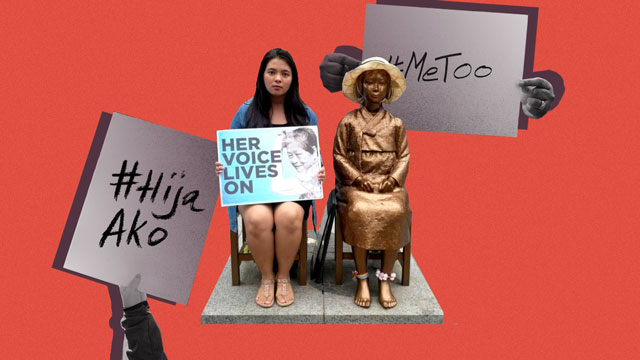

26 June 2019. Wednesday. Noon.
Out of breath from running around the city with a big placard in one hand and a heavy, borrowed tripod on the other, I stood in front of the Japanese embassy in Seoul with 80 other activists demanding for an official apology and reparations from the Japanese government. After that day’s demonstration, Jacqueline Lingbaoan, a Filipino-Canadian volunteer for the House of Sharing, carefully maneuvered an exhausted Lee Ok-Seon-halmoniinto into the backseat of a van.
“Lee Ok-Seon-halmoni was expecting a big crowd today and there was indeed a huge crowd,” she said. “The grandmothers have been standing on the exact same spot for the past 30 years. Now…they have to sit beside everybody else because of their conditions. But their voices are just as loud as it was [back in 1992].”
The Wednesday Protest is a weekly protest that has been held 1,438 times since January 1992. Whenever their health permits a grueling three-hour travel to the city center, the halmonis endure the long commute to attend the demonstrations. The purpose of this protest is to demand that Japan formally apologize and accept historical responsibility for the atrocities it has committed against “comfort women” and to educate future generations by including this tragic piece of history in the Japanese educational curriculum.
Who are the comfort women? After the international backlash that Japan faced following the Nanking Massacre, the Emperor ordered the creation of “comfort stations” or military brothels to provide constant sex for soldiers to prevent the spread of sexually transmitted diseases. However, as these comfort stations expanded, Japanese prostitutes could no longer meet the growing demand. As a result, thousands of women from occupied territories were forcibly conscripted to these brothels. Many survivors testify to having been raped by up to 70 soldiers daily. (READ: Comfort women: 'Hustisya para sa mga lola')
According to historian Yanson Ahn, sexual violence in Japanese comfort stations have become a routinized everyday practice. In fact, it is a common sight to see long lines of soldiers queuing up for sex with their “trousers down and underpants already almost off.” Many soldiers begin to unbuckle their trousers outside the door and would come out of the room naked. Each soldier is expected to finish “intercourse” quickly as there are still those waiting for their “turn.” The imagery conjured by these descriptions looks very much like the queue for a public toilet. These women were dehumanized to the extent that their bodies have been reduced to being “toilet structures.”
My own cathartic exploration of the harrowing plight of the survivors of institutionalized wartime sexual slavery began on the second floor of the Wilfrido Ma. Guerrero Theater in UP Diliman. As I was watching the actress who played Nana Rosa endure 9 months of dehumanizing abuse, I promised myself that I would do everything in my power to keep their story alive. It is true what they say — art really should “comfort the disturb and disturb the comfortable.” This is precisely the reason why in the last year, I have been spending my breaks from law school tracking down the remaining survivors of institutionalized military sexual slavery.
Lola Lita Vinuya and the Malaya Lolas Organization
On 23 November 1944, mortar rained down the quiet town of Mapanique as the Imperial Japanese Army doused houses with gasoline, ruthlessly bayonetting every last man they could find. The Japanese soldiers hauled the women into the Bahay na Pula, where they were repeatedly tortured and raped. As a result of the abuse they suffered as children, a lot of the survivors left the village for fear of the stigma and persecution attached to being a rape victim. Some were so traumatized and repulsed by male companionship that they refused to marry and have children.
Holding a red plastic bag of nganga, Isabelita Vinuya (Lola Lita) had a glazed, faraway look in her eyes as she was narrating to me the fateful day when the Japanese Army raided her village. Lola Lita was just 11 years old when she was forcibly taken to the Bahay Na Pula to be brutally raped and subjected to various forms of sexual humiliation and violence. Nearly 7 decades later, she filed a case against the Philippine government to order the President to espouse their claims against the Japanese government. But when I asked her if she recalls why she lost that highly controversial case, she barely remembered that there was even a case to begin with. Since they lost that case in 2010, Filipino comfort women barely made the headlines of popular news agencies in the country. Since then, many members of the Malaya Lolas Organization and Lila Pilipina have died. Their identities, and consequently their lived experiences, were left in the margins of history.
The predecessors of the #HijaAko Movement
Before the #HijaAko Movement, there were the comfort women. The #HijaAko Movement originated from an online spat between Ben Tulfo and Frankie Pangilinan, when Tulfo tweeted that women should not wear revealing clothes so as not to “unleash the beast.” In an attempt to debunk the antiquated misconception that a woman’s clothing causes rape, women from all over the country came forward with their own stories of sexual harassment and abuse. It sparked meaningful conversations on issues that were previously considered taboo, such as the prevalence of workplace sexual harassment, date rape in college parties, sexual grooming and predatory behaviors of faculty members in Catholic private schools, and the misogynistic “locker room” talk in university fraternity group chats. (READ: Rappler Talk with Kakie Pangilian: #HijaAko and finding one’s voice)
We should recognize that the #HijaAko Movement is not merely a “Filipinized” incarnation of the #MeToo Movement, because it is organically built upon the pioneering initiatives of early activists against gender-based violence and systemic sexual abuse — the comfort women. Self-identification as a comfort woman is deemed as a “symbolic act of rebellion” at a time when female chastity and virginity were considered as the most important virtues of a woman. At its core, the HijaAko Movement is founded upon a victim-centered approach, which denounces the culture of impunity and “structural silencing” that followed these abuses. (READ: 'Inviting the beast'? #HijaAko trends as women call out victim blaming)
“Sabi ni nanay, ‘Kapag muling binigkas, muling nagkakatotoo.’ Kaya sa isip ko lang binibigkas,” says Nana Rosa. For nearly 50 years, Nana Rosa kept her story a secret. But hearing Kim Hak Sun speak out over the radio inspired her to break her silence and tell the story of her abuse. Like what Kim Hak Sun’s 1991 testimony did for Nana Rosa, the #HijaAko Movement is all about women empowering women. After her first press conference in 1992, 29 women came forward within months, as they were “encouraged by seeing Lola Rosa on television.”
I have always believed that memorialization of history and the establishment of statues help us confront and heal from the painful narratives of the past. And so, a few hours before my scheduled flight back to Manila, I laid flowers at the bronze statue of a girl — the Statue of Peace promising her that her story their story — will never be forgotten.
In memory of Maria Rosa L. Henson
(5 December 1927-18 August 1997).
Your voice lives on.
– Rappler.com
Ma. Hazel Joy Faco is a Juris Doctor student specializing in International Human Rights Law in Ateneo de Manila University. In 2017, she graduated with a degree in Political Science in UP Diliman. Formerly a legal intern for the Humanitarian Legal Assistance Foundation, she now works for the Commission on Human Rights – Child Rights Center and the Ateneo Human Rights Center.